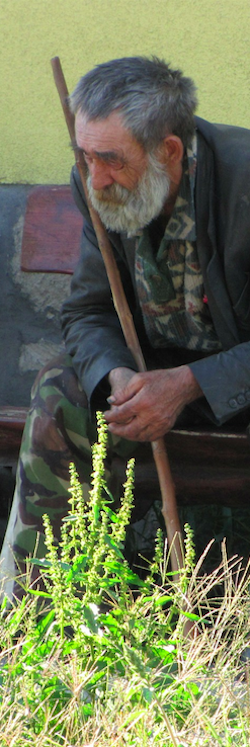[The following is the script that I worked from when putting together this video, provided as a resource. Because I record in a single take, there may be variations from what is spoken and this text.]
Imagine a biologist who only studied plants. It’s not hard, because that’s what scientists do: they specialize. They learn as much as possible, as deeply as possible, becoming an expert.
But imagine now that this scientist said that he or she was studying “all living things,” the “nature of life,” and took for granted that the insights gained from studying plants told them all they needed to know about how all living things worked — mushrooms, lichen, animals of any sort, insects (even though we know of 4 times as many insect as plant species). Of the species of life we’ve catalogued, plants make up less than 17%.
 That’s IS the current situation in psychology. Actually, it’s worse. As a number of psychologists have pointed out, their research disproportionately examines people from their own home countries, from the wealthiest industrialised nations. Even within those countries, the subjects tested by psychologists are disproportionately university students, young adults who happened to register for an introductory psychology class. These are the vast majority of recruits for psychology experiments. To put it another way, if you’re a university student, you are 4000 times more likely to get recruited for psychology research than any other person.
That’s IS the current situation in psychology. Actually, it’s worse. As a number of psychologists have pointed out, their research disproportionately examines people from their own home countries, from the wealthiest industrialised nations. Even within those countries, the subjects tested by psychologists are disproportionately university students, young adults who happened to register for an introductory psychology class. These are the vast majority of recruits for psychology experiments. To put it another way, if you’re a university student, you are 4000 times more likely to get recruited for psychology research than any other person.
Psychologist Jeffrey Arnett reported in a 2008 article in American Psychologist that 96% of all subjects in psychology research were drawn from countries that represented only 12% of the world’s total population (Arnett 2008).
12% of all people are left-handed. In the UK, about 12% of the population experiences depression each year. In Australia, 12% live below the poverty line. Earlier this year, the Eurozone had 12% unemployment. In the US, 12% of adults have diabetes; California has 12% of the US population. Only 12% of us stick with our New Year’s resolutions.
So is it really sound to base our understanding of human nature on a close study of 12%?
Because even within these countries, undergrads are the predominant subject, Arnett suggested that psychology research was neglecting 95% of the world’s population. Some psychologists are acutely aware of this problem, and they push their field to be more global, more interested in the variety of human nature.
In 2010, Joseph Henrich, Steven Heine and Ara Norenzayan wrote an article that laid out the problem in detail (Henrich et al. 2010b; see also 2010a). They suggested that psychology subjects were the ‘WEIRDest people in the world.’ By that, they meant that way subjects were recruited was biased to favour people who were Western, Educated, Industrialised, Rich and Democratic. We know lots psychologically about WEIRD people, less so about the rest of us.
This sampling bias wouldn’t be a problem if we could be confident that everyone else on the planet resembled the WEIRD people. Some psychologists might be working with that assumption, but Henrich, Heine and Norenzayan make clear what a problem this is. That is, WEIRD people are weird in another sense.
 Wherever we have good cross-cultural psychology data, WEIRD subjects aren’t ‘normal’ or ‘average’ or even just a little bit different. They’re often real outliers. If you play strategy games meant to test people’s sense of fairness, WEIRD subjects behave in extreme ways compared to other groups, such as herding peoples or foragers. In fact, when Hernich and his colleagues looked at the data, WEIRD subjects turned out to be outliers on…
Wherever we have good cross-cultural psychology data, WEIRD subjects aren’t ‘normal’ or ‘average’ or even just a little bit different. They’re often real outliers. If you play strategy games meant to test people’s sense of fairness, WEIRD subjects behave in extreme ways compared to other groups, such as herding peoples or foragers. In fact, when Hernich and his colleagues looked at the data, WEIRD subjects turned out to be outliers on…
- visual perception,
- fairness,
- cooperation,
- spatial reasoning,
- categorization and inferential induction – that is, the way we extrapolate from what we already know —
- moral reasoning,
- reasoning styles,
- self-concepts and related motivations,
- the heritability of IQ.
- Even really basic sensory factors like whether or not you fall for an optical illusion, turn out to suggest that Western subjects are outliers.
WEIRD subjects, for example, fall the most for the Müller-Lyer illusion. In some populations, this simply is not an illusion; if you’re a San forager or a South African miner, you’re liable to see at a glance that these lines are the same length. Cross-cultural psychologists think that it takes living in a world of perfectly right-angle rooms and carpentered spaces to train your visual system to think these lines are different lengths.
As they write in their conclusion:
Although we are certainly not the first to worry about the representativeness of prevalent undergraduate samples in the behavioral sciences… our efforts to compile an empirical case have revealed an even more alarming situation than previously recognized. The sample of contemporary Western undergraduates that so overwhelms our database is not just an extraordinarily restricted sample of humanity; it is frequently a distinct outlier vis-à-vis other global samples. It may represent the worst population on which to base our understanding of Homo sapiens. (Henrich, Heine and Norenzayan 2010: 81)
But there are two additional issues with the possibility of extrapolating from WEIRD subjects. First, the very description WEIRD – wealthy, educated, industrialised, and so on – may be self-flattering. It’s how Westerners and other wealthy people like to think of themselves.
 Elsewhere I’ve argued that it may not be the WEIRD qualities that make these subjects such outliers. Maybe Western university students are outliers because they’re (MYOPICS)
Elsewhere I’ve argued that it may not be the WEIRD qualities that make these subjects such outliers. Maybe Western university students are outliers because they’re (MYOPICS)
Materialist, — other people inhabit a world of spirits and non-material forces; Westerners tend to think objects and non-objects are clearly distinct;
They’re Young, not just because they’re university students, but even in relation to people the same age in other societies, who may already have families and leadership roles in the community, rather than still being in an extended kind of adolescence;
MYOPICS may be more self-Obsessed, in a variety of ways, including the idea of building a career and not having a strong corporate identity like a clan or extended family [oops];
Pleasure-seeking, and pain aversion may be greater;
University students, especially in US research universities, may ironically be more socially Isolated, sometimes living in age-graded, residential colleges where they don’t interact with older or younger people regularly;
MYOPICS live in pervasive Consumerist society, often don’t have identities based on production or occupation,
And finally, Westerners in general are terribly Sedentary by every measure, which may shape their psyches and nervous systems in powerful ways.
The second problem is that our understanding of human psychology is not only built disproportionately on studying these types of people. It’s disproportionately built by these types of people, shaped by the questions that WEIRD researchers asks, by the fascinations (and blind spots) of this group of people (who we know are outliers).
To borrow from Donald Rumsfeld, it’s not just the things we know we don’t know, it’s the ‘unknown unknowns.’ The questions that we haven’t asked about human experience because we don’t even know that we haven’t asked them.
This is one place that psychological anthropology and neuroanthropology comes in: anthropologists are accustomed to exploring – alongside people who are quite different to us, WEIRD in their own ways – the many ways that humans are. We don’t have to imagine human variation or try to derive it from university students. We can talk with those who live in quite different ways, study their songs, mythologies, rituals, and day-to-day lives, and learn more about what is possible.
 It’s not a problem if you’re WEIRD. It’s a problem if you don’t know you are…
It’s not a problem if you’re WEIRD. It’s a problem if you don’t know you are…
References
Arnett, Jeffrey. (2008) The neglected 95%: Why American psychology needs to become less American. American Psychologist 63(7): 602–14.
Henrich, Joseph, Steven J. Heine and Ara Norenzayan. 2010a. Most people are not WEIRD. Nature 466(1): 29.
Henrich, Joseph, Steven J. Heine and Ara Norenzayan. 2010b. The weirdest people in the world? Behavioral and Brain Sciences 33: 61-135 (with commentary). doi:10.1017/S0140525X0999152X
Video production credits
Photo credits:
Most images are public domain, especially from Pixabay (which Greg uses constantly).
Some images are Creative Commons or require attribution:
- Inupiat Family from Noatak, Alaska, 1929 By Edward S. Curtis. Public domain.
- The Scout in Winter, Crow, 1908, by Edward S. Curtis – United States Library of Congress’s Prints and Photographs division. Public domain.
- “A smoky day at the Sugar Bowl–Hupa” by Edward S. Curtis – Northwestern University Library, Public domain via Library of Congress, Prints and Photographs Division.
- “Saami Family 1900” by Unknown. Public domain via Library of Congress, Prints and Photographs Division.
- South Africa Gold Miners from the Carpenter Collection, ca. 1890-1923 (LOC). Believed to be in Public Domain.
- Young coal miners in South Africa. 1/Jan/1988. UN Photo/P Mugabane. http://www.unmultimedia.org/photo/ CC (NC ND 3.0). Flickr.
- Gold ore, View of Sindri village gold miners, Burkina Faso. Photo by Ollivier Girard for Center for International Forestry Research (CIFOR). CC (BY NC 3.0). Flickr.
- Photo of graduate from College of DuPage Commencement Ceremony, 2014. Flickr.
- Photo of a young boy working in a shipyard outside of Dhaka, Bangladesh. by Zoriah, CC (BY NC 3.0). Flickr.
- Photo of child labor by Zoriah, CC (BY NC 3.0). Flickr.
- Photo of child with younger brother by Ross Pollack, 2013, the Philippines, CC (BY NC SA 3.0). Flickr.
- Photo of child dancing 2012. El Fasher: Children from Abu Shouk camp for Internally Displaced Persons (North Darfur), by Albert Gonzalez Farran – UNAMID, CC (BY NC ND 3.0). Flickr.
- SCA Svenska Cellulosa Aktiebolaget SCA at Career Days 2011 in Stockholm – The career fair. CC (BY 3.0). Flickr.
- Sleeping university student photo by D. Sharon Pruitt, owner of Pink Sherbet Photography, 2011. CC (BY 3.0). Flickr.
- Men in Kilts by cobalt123, 2008, CC (BY NC SA 3.0). Flickr.
- Honour guard of the Afghan National Police (ANP) by UN Photo/Eric. Kanalstein. Kabul, Afghanistan, 05/02/2011. Photo ID 462625. CC (BY NC ND 3.0). Flickr.
- Cliff dwelling – Keet Seel – Kawestima – Navajo National Monument by Al_HikesAZ, 2012, CC BY NC. Flickr.
- Audience scene Wu-Tang Clan på Sentrum Scene 2010. Foto: Rashid Akrim, NRK P3, 2011, CC BY NC SA. Flickr.
Icons:
All icons by The Noun Project designers
Creative Commons licensed (BY 3.0)
- Bank by Emily L
- CEO by Mark Bult
- Factory by Patrick Trouvé
- Fireworks (rockets) by Juan Pablo Bravo
- Fireworks (burst) by Tracy Hudak
- Globe by Doug Cavendish
- Student by Hyuk Jun Kwon
- Talking by Hadi Davodpour
- University by Daniel Turner
Music:
- ‘Purple Nurple’ by goldfish, 2010. Creative Commons (BY 3.0)
- “Urbana-Metronica (wooh-yeah mix)” by spinningmerkaba, 2011. Creative Commons (BY 3.0)
Both songs (and more) available at http://ccmixter.org/
Written, spoken and produced by: Greg Downey
© 2014 Greg Downey
Macquarie University, Department of Anthropology
‘Weird Psychology’ is part if the Open Education collection, ‘Neuroanthropology 101: Body, Brain, Culture.’ 2014.
The video is freely available for your use through a Creative Commons (BY ND 4.0) license.
All resources used in the production were public domain or Creative Commons licensed and this use complies with all conditions. If you are the rightful owner of any media used in this production & object to its use or believe that it has been used incorrectly, please contact Greg Downey (information at neuroanthropology.net).
 A free media production of Enculture Press and Neuroanthropology.net.
A free media production of Enculture Press and Neuroanthropology.net.

One thought on “Video 1 script & credits”